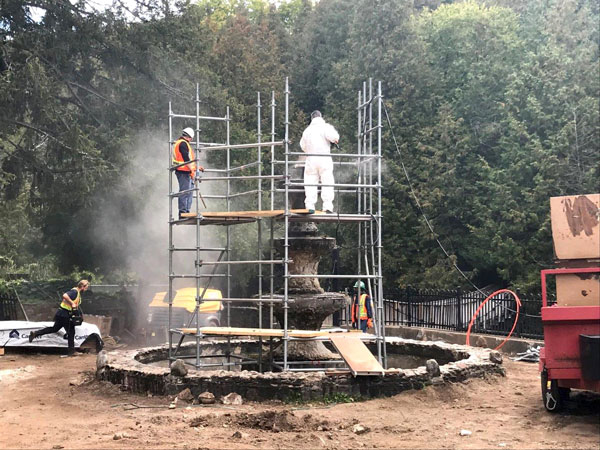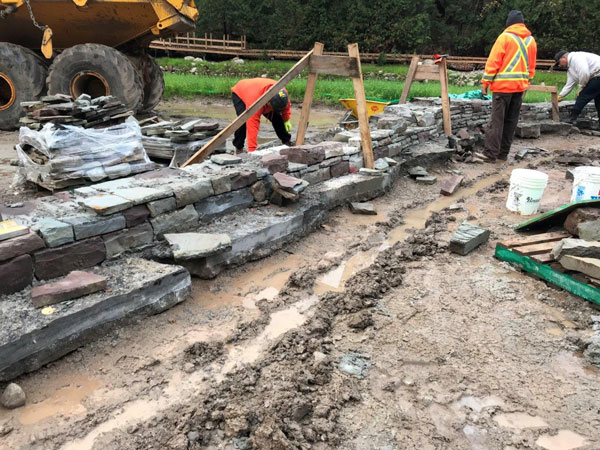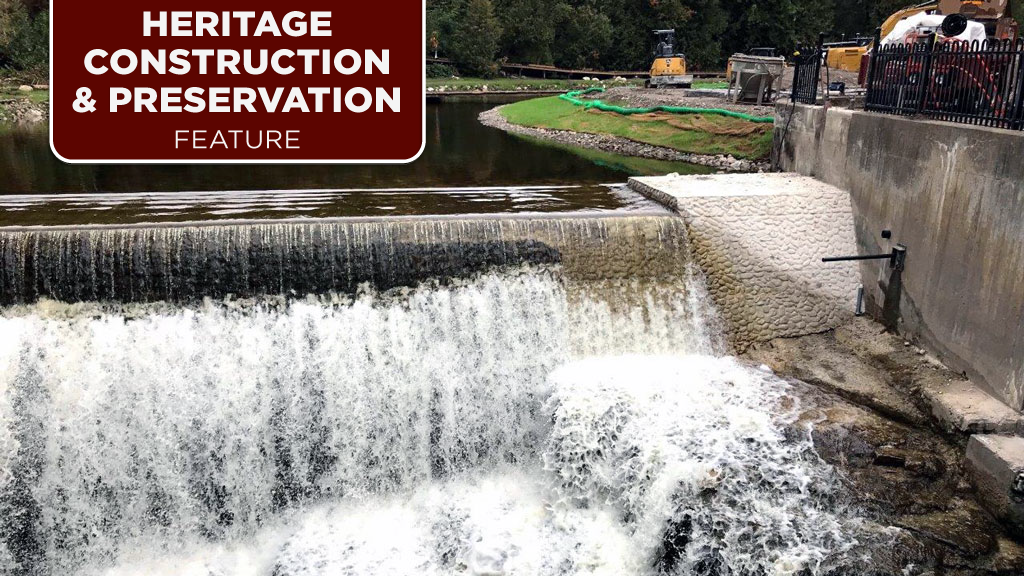After being closed for more than a year for a critical restoration, the popular and iconic Belfountain Park in Caledon was reopened in June by the Credit Valley Conservation.
Overseen by general contractor R&M Construction Inc. and encompassing a number of specialized subcontractors, the two-part first phase restoration was primarily intended to restore the ecological health of the West Credit River which flows through the area, as well as addressing health and safety issues centering around a dam which spans the river.
Constructed of stone in the early 1900s and then encased in concrete in the early 1960s, a few years after the conservation authority acquired the property, the dam’s head pond was the repository of decades-long sediment which was raising the water temperature and threatening cold water fisheries, says authority project manager and landscape architect Scott Cafarella.
For many years the authority actually lowered the head pond by opening the dam’s sluice gates and then excavating and hauling away the sediment, as well as power washing the dam. That yearly procedure was cancelled in the late 1980s, as it was no longer deemed “best practices”

But the sediment continued to accumulate and to tackle the problem the authority undertook, first, a master plan and then an environmental assessment.
Finished in 2017 the environment assessment by Amec Foster Wheeler (now part of the Wood Group) evaluated several options but concluded the preferred alternative was to lower the dam spillway by one meter, removing the sluicegate and creating a naturalized channel through the head pond, he says.
“We didn’t want to lose the dam,” says Cafarella, explaining that option was intended to address the environmental impacts without the loss of major heritage feature which is part of the visitor experience of the park.
Ontario’s Ministry of Natural Resources gave the authority a five-year window to complete the project and several other provincial and municipal permits were required, he points out.
Wood Environment and Infrastructure Solutions, Matrix Solutions, Brook McIlroy, and GM BluePlan were the consulting teams on the project which got underway earnest in July of 2021.
In an intense highly-coordinated three-month endeavor designed to comply with Department of Fisheries and Oceans in-water work regulations, the task of lowering the dam was comprised of several sequenced and interrelated tasks.
After removing the stop logs from the sluiceway to slowly bring down the water level in the head pond, the contractor built an access road and temporary river crossings for its heavy equipment and then installed flow control bags and diverted the flow of the river into a bypass channel, he says.
The next steps included removing the sediment from the head pond and then shaping the new naturalized channel with infill material and rocks for the banks.
Once those procedures were in place, the cutting away and removing of six 1.5-metre-deep sections of the —as per the 2017 environmental assessment plan recommendations—commenced. Because of their weight and volume, five were crushed on site.
“One 18-tonne piece was retained and placed nearby as an interpretive feature to show the cross section of the original dam.”
Lifting it required the use of a 130-ton crane, which was one of 12 pieces of heavy equipment on site, he says.
After the dam was structurally reinforced with rock anchors and a new 0.5-metre-high concrete cap, the river was “flipped” into the new channel and now flows over the south half of the dam.
Other work included stabilizing the north retaining wall, removing the sluiceway, installing the remaining rock irons, and reforming and pouring the north portion of the dam, he says.
“We made it right on the deadline,” says Cafarella, referring to the Sept. 15 deadline the in-water work had to be completed.
But that was only the first half of the restoration. The conservation authority also used the project to carry out other work such as rehabilitating the park’s cultural heritage features and aging infrastructure. And the park has quite a history, he points out.

An industrial site in the 19th Century with at least three mills operating on the river, what is now the park became the summer home of Canadian inventor Charles Mack in the early 1900s. The inventor of the cushion rubber stamp, he created a number of “follies” such as a grotto, stone terraces, and stone steps, a tiered stone fountain, and a suspension footbridge with the help of local resident Samuel Brock, who was also a part-time trapper.
Follies are nonessential buildings or structures which serve as garden focal point and are an integral part of the English Picturesque Movement, which Mack was a devotee of, says Cafarella.
While Mack’s home and other structures have long since disappeared, a significant number remain and were reconditioned. A major example was the restoration of the park’s historic 1914 fountain by Clifford Restoration.
This phase also included the building of a lily garden and new meandering low stone walls by Dean McLellan Stonework, the erection of a new pedestrian bridge, and the installation of premanufactured metal “fox follie”.

Its purpose is for sightseeing and photography, and a rest stop. But it also provides a link with the early 20th Century follie creations of Charles Mack and Samuel Brock, says Cafarella.
Consultations with the local community on a Phase Two restoration are planned to start in 2023. Phase Two will include the construction of a new visitor centre and washrooms and improved parking, he says.











Recent Comments